(Editor’s note: Today’s guest post explains many factors you should think about when considering the AR-15 for home defense. Be sure to check the legality of owning an AR-15 in your state. Learn and practice gun safety in every situation.)
Written by Benjamin Worthen
Is a rifle the best choice for a home defense gun?
The age old question about what’s best for home defense is starting to swing in favor of the battle rifle build. But should it be? It’s much more complicated than just stopping power, or ease of mobility, or crossover between guns you already own, or friendly fire concerns. Let’s talk about why an AR is a premium option for home defense, but let’s also talk about why it’s not a perfect choice for everyone.
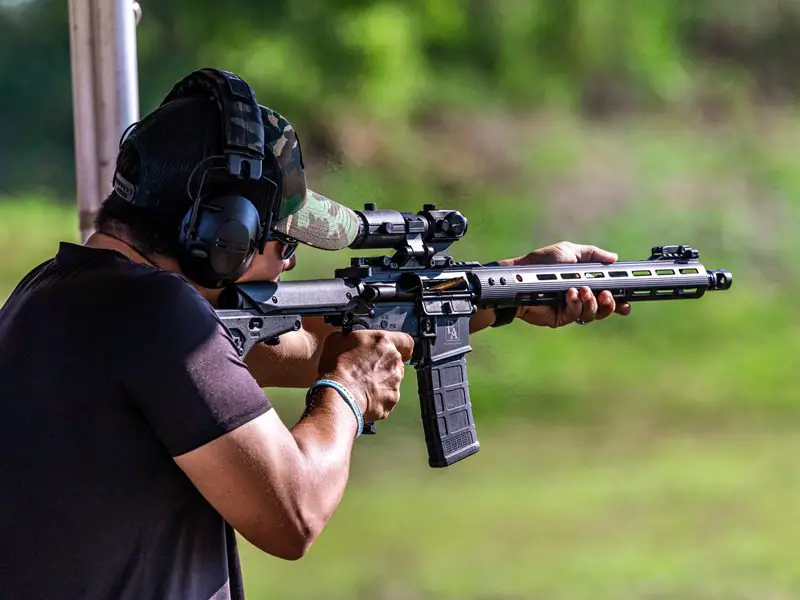
A rifle can provide the ultimate in stopping power, thanks to the high-powered cartridges it offers, and in an AR, which will be highlighted later by characteristics, this is heightened by the familiarity it provides, and the makeup of the modular style and how it can be customized down to the tiniest details.
Why a rifle is a fantastic choice for home defense:
Stopping power, proven reliability, and ease of use after basic training
In most cases a single shot from a rifle is enough to stop a majority of threats
Shoulder fired, harder to lose control of
Allows for a better defensive posture and does not easily become mitigated by objects in the field of fire
Can be accessorized easily
Can cover more than just a hallway – good for bigger properties
Easily controlled by a defender
All of the above bullet points are enhanced by the fact that an AR is the rifle of choice for home defense.
Things you might be overlooking when considering a rifle for home defense
Even small caliber centerfire rifles (and some rimfire cartridges) have projectiles that can shoot through multiple walls, even if you are using specialty ammunition (like frangible rounds)
Friendly fire or neighborhood risk is a real concern for many people
Some rifles aren’t easy to move through normal home footprints without raising and lowering the muzzle in compromising positions
Clearing rooms (which may or may not be advisable depending on your situation) is infinitely more difficult with a full sized rifle
Rifles are loud. Percussion is massive in an enclosed space; without a suppressor which adds bulk, weight and length to your gun and has regulatory hurdles, you are likely to have at least temporary damage to your hearing (handguns/shotguns are not safe either, generally)
Most people need more training than they have currently, and many feel super competent with a well outfitted rifle, when they may be lacking severely in how to use a rifle in a small footprint or close quarters battle
Why the AR is so popular as a home defense option
The AR is an enigma, like the 1911. It’s not perfect, but it has loyal fans and longstanding value. There are a ton of cosmetic changes to the AR over the years and they look different than they did in the late 60’s, but they are still viable, effective platforms.
The average shooter loves the AR for a couple of reasons though.
1. Choice, customization and proven performance
2. Handling and ease of understanding with no obvious day-to-day usage weaknesses
The caliber is considered small, but it’s not impotent. We use it as our national warfighter cartridge of choice for mainstream soldiers – many, if not most special forces operators also opt for it even when given other choices.
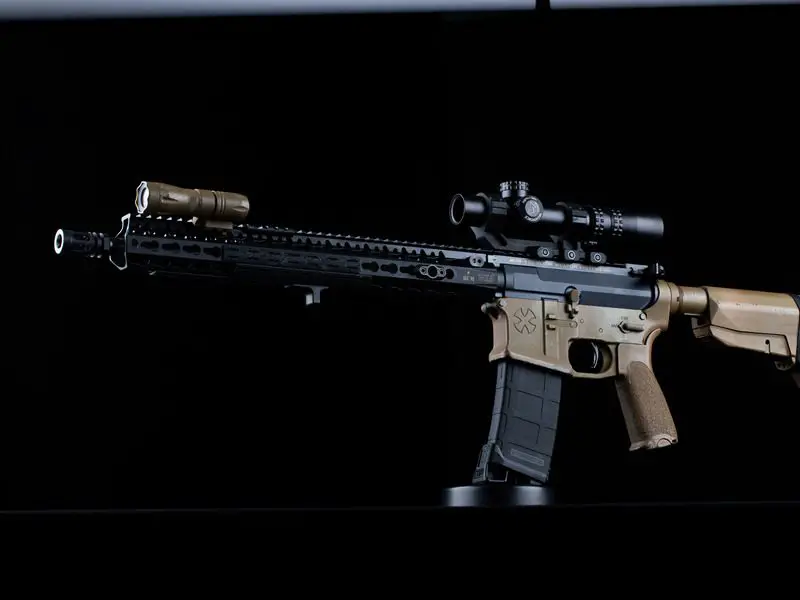
The field stripping and maintenance is approachable, easy to do and basically foolproof.
The AR is comfortable, relatively lightweight for the functionality it gives and it offers good capacity of rounds, with easy to understand processes and can be configured to meet your specific ergonomic or functional needs.
The parts are easy to find, replace, service and afford.
The tooling to maintain and build the platform are easy to obtain, use and afford
The mainstream has adopted it as “America’s Gun”.
If you use it on the range because it ticks so many boxes for you, why wouldn’t you use it in a defensive scenario if it also ticks those boxes?
Finally, you can make the gun short, powerful, easy to use and accessorize it to your liking without running a 20 lb. behemoth. You can move a carbine version or a pistol version around the house easily if it’s configured that way, making your job easier and more efficient from an engagement perspective.
It’s hard to hate an AR for home defense.
Cartridge choices and how you can optimize for your unique scenario and home style
While the United States Armed Forces do use the cartridge by choice that the AR natively is chambered in, it doesn’t mean that it’s the be-all-end-all for everyone. It’s not particularly well suited to single shot stoppages in all cases, and the mainstream loads for the gun, prioritize lower weight projectiles that don’t offer generous wound channels under certain circumstances.
That said, you’d be hard pressed to find a reason that a 5.56/.223 couldn’t be used for home defense.
There are a few edge cases that may make others more favorable, however:
The 5.56/.223 isn’t as easy to suppress as say, a 300BLK, and it doesn’t have the bulk in the projectile that the .300BLK has.
The projectile while it may tumble after a drywall or wall stud hit, may still be traveling fast enough to cause a sufficiently dangerous second target friendly fire concern
The cartridge isn’t as potent as others available on the same platform.
.223/5.56 As A Home Defense Option
Again, don’t try to mix metaphors – the 5.56/.223 is a perfectly good home defense round, especially if you have varmint needs, a big property or don’t have friendly fire concerns. It’s a legitimate round, proven on every battlefield since the 1960’s. Even in Vietnam, where the cartridge wasn’t ideal for the heavy foliage, it was still the weapon of choice for the military in the environment.
The .30 Carbine round is also a great home defense option but has penetration concerns of its own too. If given the choice between the two rounds, and the platforms that offer them, it’s a natural choice in favor of the 5.56/.223 for home defense.
.300Blk As a Home Defense Option
Likely to be the best AR specific home defense option if you have the following concerns:
Require a suppressor
Have a friendly fire risk
Need the AR platform
Desire a .30 caliber over a .22 caliber option
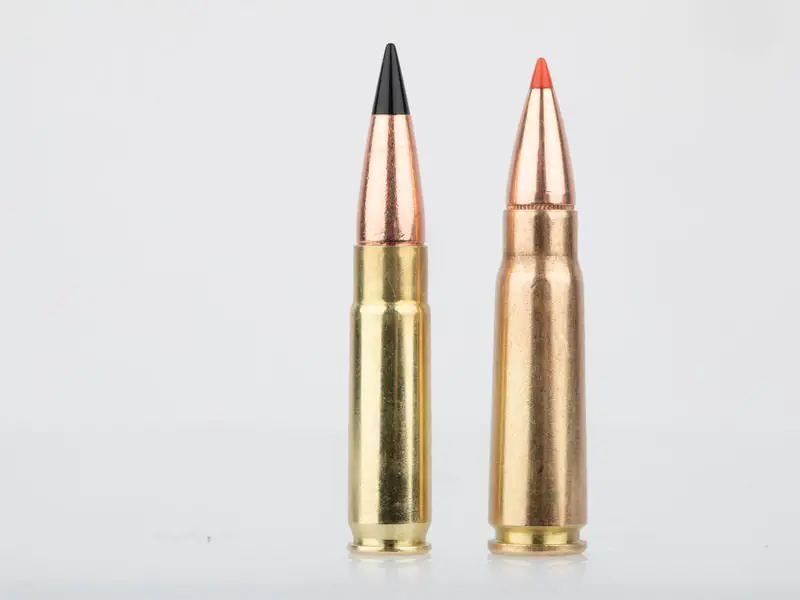
The slower round doesn’t lose much potency over the 25-40 feet you’d likely find yourself engaging in, in a home defense situation. The higher grain weight and bigger potential wound channel offers some advantage, though you do lose a bit of that impact performance because of subsonic or even supersonic velocities that are slower than mainstream 5.56/.223.
It’s a MUCH better user experience when suppressed thanks to the lack of supersonic crack and the positioning and engineering of the cartridge.
It works in a standard AR setup with few changes needed. You can buy a drop in upper and use the same mags and bolt.
6.8SPC Is a Possibility
The purpose-built intermediate round is meant for a new type of warfighter. The 6.8 delivers higher energy than the 5.56/.223 – more than 40% higher. It is also engineered to fit into the magwells and basic architecture of the AR-15.
It doesn’t compete with the .308/7.62 ballistically, but it isn’t far off, and it doesn’t need to for home defense. A .308 in a standard tract home that most readers would be inhabiting would be overkill on several levels, not the least of which is penetration and second hit potential.
Note: that doesn’t mean a .308 couldn’t serve as a perfectly suitable home defense choice in certain situations.
The 6.8SPC has more versatility than the .300BLK and the .5.56/.223 when used in purely defensive scenarios on most parameters. The wound channel is bigger and the damage on target is significant.
Thoughts on Pistol Calibers
A 9mm, .45 ACP, 10mm, or other popular cartridges might be a suitable option for the AR platform in the case of the home defense need, but you miss a lot of the strategic power of a rifle cartridge, and you may still have overpenetration concerns in some cases.
The AR is also optimized for and proven reliable with all of the above three cartridge options. Not all builds with pistol uppers are ultra-reliable in all situations.
If you need the carryover, and you prefer a particular cartridge, you can make the case, certainly. This is very interesting when you can use a shoulder fired rifle and a shorter overall length because of the tight hallways and doors of a residential building. That’s the best of both worlds, but it’s also nothing you cannot achieve with a basic 5.56/,223 carbine or other rifle cartridge in an AR.
Strong Advantage: Rifle builds.
Size, Build Type and Special Considerations
It will almost never make sense to build an AR for home defense that takes on the profile of a full-sized rifle. Between your body, you’re positioning and the length of the gun, it’s going to be hard to justify doing anything other than a pistol build or a carbine.
Standard hallways in tract homes are generally less than 4 feet wide. Imagine trying to transition to a 180-degree threat in such a small space with a full-sized rifle.
A further note: if it wasn’t an AR, or similarly sized, similarly functional rifle (think Steyr AUG, IWI Tavor, AK, etc.) you would never be considering it for home defense, unless you lived on a sprawling property with a need for ultra long-range potential, and with varied threats, and early warning systems in place. The mainstream reader of this article is in a setting that is likely to be less rural, and more urban or suburban.
Even with a sprawling estate and a ton of game time in Battlefield 5 or Sniper Elite or Counter Strike, you’re not using a bolt action to counter a home invasion.
An AR just makes sense. It’s familiar. It’s capable. It’s easy to maintain and deploy. The accessorizing of an AR is like child’s play compared to most other platforms. It just works. And even the most hardcore
gas-piston-only loyalists must admit a direct impingement gun at half the price, doesn’t lack for too much in reliability compared to the gas driven builds.
Magazines are cheap. Ammunition is available even during difficult times – at least on the secondary market. Try getting some of the obscure rounds during market woes. It’s a shoulder-fired option, harder to wrestle away from the user and recoil is manageable, if not weak. A few range outings and the controls become very familiar, even to newcomers. It’s a no-brainer.
Other Concepts That You May Want a Deeper Dive On
Upper receiver build availability makes the AR an unmatched option for those that want to customize and use plug and play components. The Modularity of the AR is what makes it so interesting to many shooters.
Suppressors/Silencers for Home Defense purposes
This isn’t the time or the place to try to explore suppressors for home defense, or even breach the conversation in support of suppressors for all. Suffice it to say: the use of a suppressor in a home defense scenario is optimal. The regulatory hurdles, especially on the state level for some folks are voluminous. It’s not just navigating a complex tax stamp and background check.
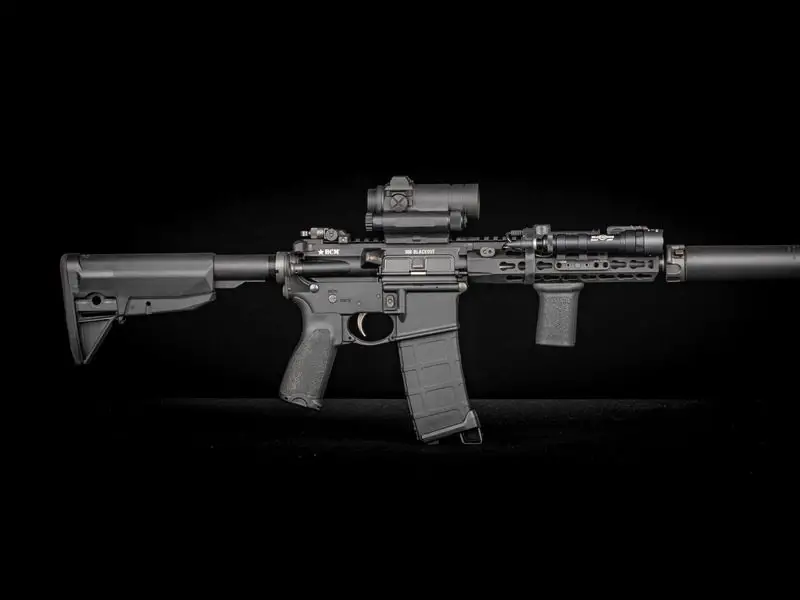
Here’s the thing though: advocates for suppressors know that you cannot risk loss of hearing caused by not wearing ear protection in a home defense scenario. But you need to hear what’s happening. As a standalone concept, you should also be concerned because a gunshot made by any gun, and especially a high-powered rifle in a domicile will cause some damage to your hearing.
So, for anyone who wants optimized protection for their hearing, and optimized threat recognition, a suppressor discussion is one you should be having with yourself. Deep dive on it if you feel the need.
Load Types
You could use the same rounds you go to the range with. In the case of the 5.56/.223 you’re using the equivalent of the armed forces NATO round. It seems sufficiently proven.
In other cartridges, you can usually get similar loadouts.
But maybe a good look at certain projectile types that are better suited to thin wall construction, or which minimize second strike potential, or which prioritize energy dump in shorter ranges with less penetration needed, could make sense.
You aren’t likely to want to use monolithic copper hunting projectiles for in-home encounters of the defensive nature. Basically: do your own research on loads for your chosen cartridge and make sure the ballistic focus matches your desired results.
Friendly fire is a BIG concern. If you are shooting and your loved one is in the room directly behind your target, you cannot take that shot without hesitation. In fact, it can be so important to the scenario that a whole industry is built for that equation. It’s one of the reasons some people opt for shotguns with higher density shot with smaller projectile sizes over say, an AR.
It’s something you should deep dive on to at least be sure of your commitment to utilizing a rifle in a home defense situation over an alternative. Only you can decide and plan for mitigating risk in a situation that could involve a risk of over penetration or a missed shot and the unintended effects of such a thing.
Accessories That Make Sense on a Home Defense AR
A flashlight – you need to see what you’re shooting at
A magazine backup
A forward assist and malfunction training
A suppressor
A laser for those who need the help or who are not trained on other aiming devices
An optic that can get you on general targets quickly like a red dot
A sure grip on the front end of the rifle
Beyond a backup gun and a flashlight, it’s hard to prioritize a lot of accessories. The timeline of an in-home encounter is too convoluted and short to engage with many accessories anyway.
Some accessories that may NOT make sense for home defensive purposes on an AR
Along those lines: many accessories will probably end up as dead weight in most home defense scenarios.
Here are a few:
Any kind of a sling will likely never get realistic use, and may even prohibit your movement or mobility in some ways
Glass optics for longer ranges
Significant capacity magazines or things like drum magazines – that’s a lot of firepower for an engagement that is likely to end with fewer than 3 shots from an AR
Extended anything, other than a safety/live switch, which can help in times of extreme adrenaline when you must rely on muscle memory and training.
Any non-functional accessories like a suppressor wrap, or fake suppressor, or anything that extends the length or bulk of the rifle like a long muzzle contraption or a bipod.
Here’s the bottom line: The AR is a platform built for stopping threats. It’s a perfect concept for home defense – but the story is deeper than a surface level view, as you have hopefully uncovered in this article. Be sure to do your own research and train with the tools you decide on.
That is especially true when it comes to mindset, preparation, and situational awareness. Just because you know the layout of your home, it doesn’t mean you have a lot of advantages. Think about the false alarm that had your heart racing for an hour after the alarm went off, even when there wasn’t an intruder. It’s complicated, disorienting, and uncomfortable. You need a firearm you can count on instantly.
What will you need when you wake from a deep sleep at 3am, and you’re faced with a multitude of possibilities, an aggressive threat, and a family member behind every 4 inches of drywall and studs? Plan accordingly – the AR gives you a lot of options that can help mitigate threats and risks alike.
About the author:
Benjamin Worthen is a Gunsmith of more than 25 years. He works as a writer, business and marketing consultant and industry expert in the firearms industry through his consulting practice. He is a vocal supporter of Second Amendment rights and a student of the Constitutional view of the right to bear arms.
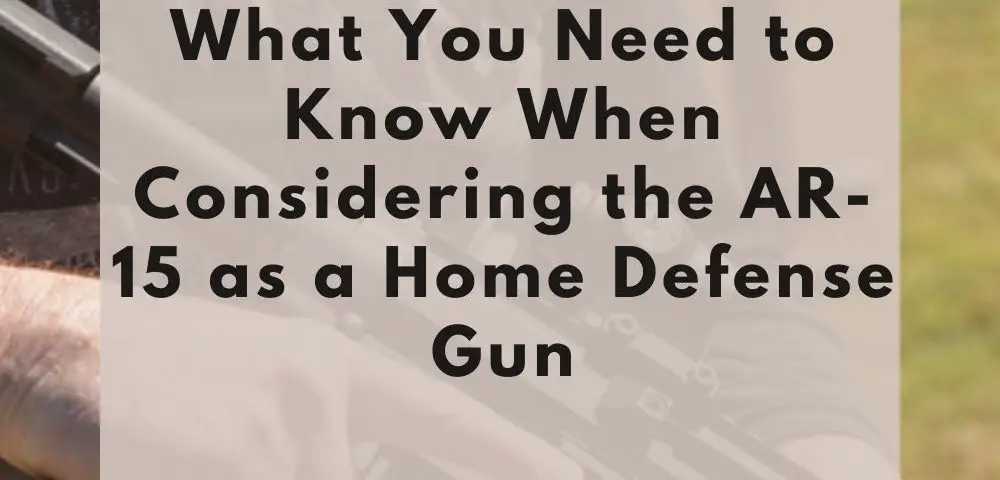


Nice article for AR specific usage. However, personally I have .45ACP for indoors, (room to room), AK47 or AR10 for yard and outside near home (no neighbors nearby), and confine my AR for potential “expeditions.” And I always carry a mini 9mm in a pocket … even when I sleep. (Can’t be too careful, can we?)
Hi Leam, Great points – thanks for sharing this. I appreciate your comment!
Your article was very informative and bring out some very good points. Living the inner city with nearby neighbor is one of the reason I opt out of having an AR-15. I am not a gun buff but I can tell you what a difference it makes with clearing building with a M4 rifle, short barrel, compared to the antiquated M16 rifle.
Good post!
Hi Carlos, You’re right, the rifle would not be appropriate for home defense while living in the inner city. Glad you like the post! Thanks for the comment.